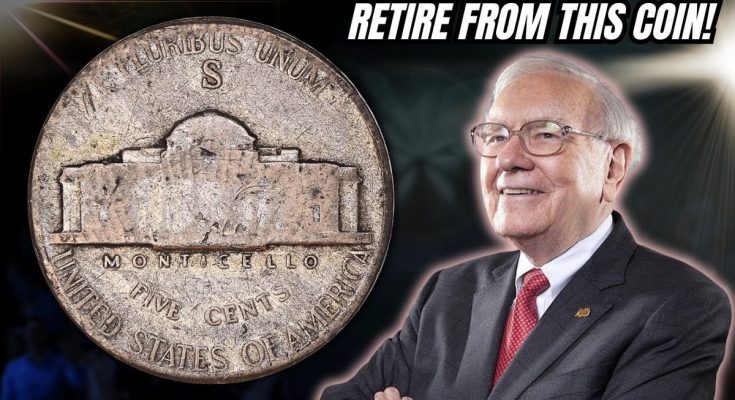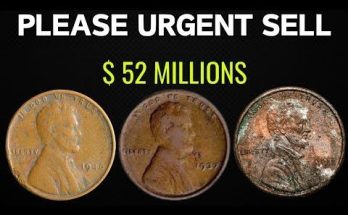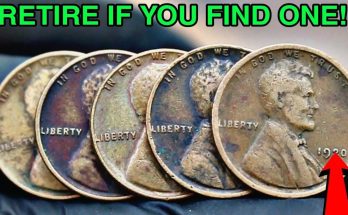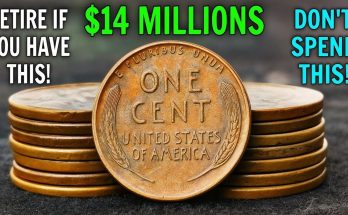Jefferson nickel with a prominent “S” mint mark on the reverse, alongside a smiling photograph of Warren Buffett. The bold text overlay reads “RETIRE FROM THIS COIN!” and the caption specifies “7 MILLION DOLLAR NICKLE: TOP 5 SUPER JEFFERSON NICKLES THAT COULD MAKE YOU A MILLIONAIER!” This is a classic example of numismatic sensationalism, a type of “clickbait” designed to captivate a wide audience by combining the allure of a hidden treasure with the authority of a financial titan like Buffett. While the claims are highly exaggerated, they are rooted in the genuine value of certain rare and exceptional coins.
The central claim of a “7 MILLION DOLLAR NICKEL” is a direct reference to one of the most famous and valuable coins in all of U.S. numismatics: the 1913 Liberty Head Nickel. Only five of these coins were ever struck, without authorization from the U.S. Mint, making them incredibly rare. Their value has consistently soared over the decades, with a specimen selling for over $4.2 million in 2022. It is this specific coin that the headline is alluding to, not a Jefferson nickel. The image, however, shows a Jefferson nickel, specifically a 1942-S, as the “S” mint mark is clearly visible above Monticello. This is a deliberate and misleading tactic, as a 1942-S Jefferson nickel, while part of the valuable “Wartime Silver Nickel” series, is not a multi-million-dollar coin.
The Jefferson nickel series does have its own rarities and valuable errors, but none approach the “7 million dollar” mark. The most notable valuable Jefferson nickels include:
- The 1964 Special Mint Set (SMS) Nickel: This is one of the rarest Jefferson nickels, with fewer than 40 examples known to exist. These coins were part of a prototype set that was never officially released to the public. Their value is high due to their extreme rarity and pristine condition. Prices for these can reach over $15,000, which is a significant sum, but a far cry from “retiring from this coin.”
- The 1942-D over Horizontal D: This coin is a dramatic mint error caused by a repunched mint mark. The underlying “D” is clearly visible sideways beneath the correctly oriented “D.” While it is a popular and valuable error, uncirculated examples typically sell for a few thousand dollars, not millions.
- The 1939-P “Double Monticello”: This error coin shows dramatic doubling on the reverse, particularly on the word “MONTICELLO” and the surrounding lettering. As a first-year coin with a significant error, it is highly sought after by collectors, with high-grade examples fetching over $1,000.
- The 1946-D over Inverted D: Similar to the 1942-D error, this coin also features a repunched mint mark where an inverted “D” is visible below the final “D.” Like most repunched mint marks, it is a key variety for series collectors and can be quite valuable in a high grade.
- The Wartime Silver Nickels (1942-1945): The image prominently features a Jefferson nickel with an “S” mint mark, which is a key characteristic of the wartime series. Due to the strategic need for nickel during WWII, the U.S. Mint changed the composition of the five-cent coin to a silver, copper, and manganese alloy. To identify these, a large mint mark (P, D, or S) was placed above the Monticello on the reverse. While not individually worth millions, a complete set in pristine condition is a valuable numismatic collection and the silver content itself gives these coins an intrinsic value well above their face value, especially in today’s market.
The presence of Warren Buffett’s image in the thumbnail is a calculated choice. As one of the world’s most successful investors, his face lends a veneer of financial legitimacy to the sensational claim. The implication is that a financial genius like Buffett would recognize the incredible value of such a coin, thereby validating the incredible claim. This combination of a valuable but not that valuable coin, a headline promising millions, and a well-known financial figure creates a compelling and shareable piece of content that, while factually inaccurate in its valuation, successfully draws attention to the fascinating world of rare coins. It encourages people to check their change, which, while unlikely to yield a “7 million dollar nickel,” might spark an interest in coin collecting and lead to the discovery of other, more modestly valuable treasures.



